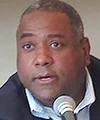 |
| Rick Gould and Robert Udowitz co-authored this article. |
Those of us who’ve worked in public relations for many years know that calls for greater diversity in the industry are nothing new. The absence of multicultural leadership within the ranks and the absence of women in top management role are two conspicuous measures of what’s not right. Lack of diversity—especially in PR agencies—is, sadly, a recurring knock on the field; thus, the industry and workplace must change significantly once and for all. If we can’t walk the talk amidst this call, then that “seat at the table” we aspire to won’t materialize in any meaningful way.
Almost three years ago, Rick wrote on this website that it felt major change might be coming, after yet another round of criticism that agencies were too racially and ethnically homogenized. Since then, the dust has settled and there hasn’t been much to show for the effort that allegedly was extended in pursuit of this goal. The past is past, but the past is also prologue.
Today, in the midst of a new wave of fervent anti-racist protests and crusades, the PR field has an unparalleled opportunity to set itself apart as never before. While the pandemic has decimated parts of the business, there’s been a strong uptick in employers and clients needing counsel on how to respond to concerns raised by Black Lives Matter and related initiatives.
More important, individual firms must take the lead proactively and start their own unique diversity transformation. They need to invest serious time and money in programs designed not only to achieve unmatched diversity and inclusion in our ranks while we also reduce groupthink about what to do—and what not to do—to get bosses and hiring managers out of their comfort zones.
Sheila Brooks, Ph.D., Founder, President and CEO of Washington, D.C.-based SRB Communications, a boutique marketing firm specializing in multicultural markets and content production, told me that over the course of her 30-plus years in the industry, she’s diagnosed several things that agencies, in particular, must do to demonstrate they’re serious about diversity in the field.
Dr. Brooks offers these four suggestions to begin with:
Open the recruitment process. Agencies need to build relationships with colleges and universities—particularly historically Black colleges and universities (HBCUs)—where they can tap and nurture talent early in a person’s career. If companies broaden their recruitment efforts, they’ll build a pipeline of talent that will enhance the agency and its clients and make for a more inclusive workforce, retention and career growth.
Internal culture. When you’ve got senior staff who’ve worked at an agency for 20 or 30 years, you’ve likely got people who aren’t flexible to change. Those firms likely need more robust staff training programs and mentoring opportunities. However, changing the organizational culture begins with C-suite level people who should lead by example. For action and change, begin by tying bonuses to executives’ pay.
Open lines of communication. Firms need more ongoing internal discussions about race and diversity from all perspectives. They need to look under the microscope to recognize the deficiencies within their organizations. Real progress begins with transparency.
Monitor. Agencies need to ensure the diverse staff they hire are content, and if not, why. If disproportionate numbers are leaving or not advancing, there needs to be a greater effort to recognize what needs to be improved to provide careers, rather than jobs, to their employees.
Dr. Brooks added that widening the base of talent provides fresh and unforeseen perspectives on how to service clients and how to help them reach their audiences. There are many factors driving such changes. For starters, agency owners are beginning to appreciate that demographics is destiny.
Another reason diversity efforts seem more legitimate now is the growing number of Millennials working in PR, many of whom seem allergic to how previous generations staffed agencies and cultivated talent. For example, Millennials are more racially accepting than previous generations and aren’t hung up on, say, interracial dating.
According to Dr. Brooks, when we talk about diversity and inclusion we need to discuss race along with socio-economic disparities in the workplace, and that also includes age discrimination and sexual orientation.
For PR firm owners and hiring managers, the ability to attract people of color, members of the LGBTQ2 community and non-traditional job candidates will require commitment from the tip-top of the organizations, persistence and, perhaps most crucial, imagination.
More and more mid- to large-size PR agencies want to buy multicultural firms nationally. There are excellent Black, Asian and Hispanic PR agencies that might be interested in selling or joining forces for executive leadership and mutual strategic opportunities.
Large agencies are also doing more internally to build their multicultural staff and management. They’re getting the message at long last.
The bottom line: Diversity is good business as well as socially, politically and morally responsible in a free society. Diversity broadens a firm’s brand appeal to a wider array of clients and prospects, unleashes more creative communication ideas and opens more productive paths for professional excellence and leadership in our rapidly evolving multicultural world.
***
Rick Gould, CPA, J.D., managing partner of Gould+Partners, is author of “Doing It the Right Way: 13 Crucial Steps for a Successful PR Agency Merger or Acquisition” and “The Ultimate PR Agency Financial Management Handbook: How to Manage by the Numbers for Breakthrough Profitability of 20% or Greater” (4th Edition).
Robert Udowitz is a principal at agency search firm RFP Associates, and senior counsellor at Gould+Partners.


 It's easy to spot whether a company's commitment to DEI is genuine or merely performative. Just as companies face backlash for neglecting DEI, they're now under scrutiny for their lack of proper understanding and action.
It's easy to spot whether a company's commitment to DEI is genuine or merely performative. Just as companies face backlash for neglecting DEI, they're now under scrutiny for their lack of proper understanding and action. Executing DEI is not just a nice to do for agencies today, but a critical need for their business success, according to Ben Finzel, president of RENEWPR and founding partner at the Change Agencies.
Executing DEI is not just a nice to do for agencies today, but a critical need for their business success, according to Ben Finzel, president of RENEWPR and founding partner at the Change Agencies.  Public corporate boards in the 21st Century need major change if they want to mitigate big risks in 2024.
Public corporate boards in the 21st Century need major change if they want to mitigate big risks in 2024. Latondra Newton has quit her chief diversity officer job at Walt Disney Co. to pursue other endeavors.
Latondra Newton has quit her chief diversity officer job at Walt Disney Co. to pursue other endeavors. Simply changing your corporate logo to a rainbow and remaining silent on the continued attacks on the LGBTQ community won’t cut it this year. Companies and organizations are going to have to take a side in this conversation.
Simply changing your corporate logo to a rainbow and remaining silent on the continued attacks on the LGBTQ community won’t cut it this year. Companies and organizations are going to have to take a side in this conversation.


 Have a comment? Send it to
Have a comment? Send it to 
No comments have been submitted for this story yet.